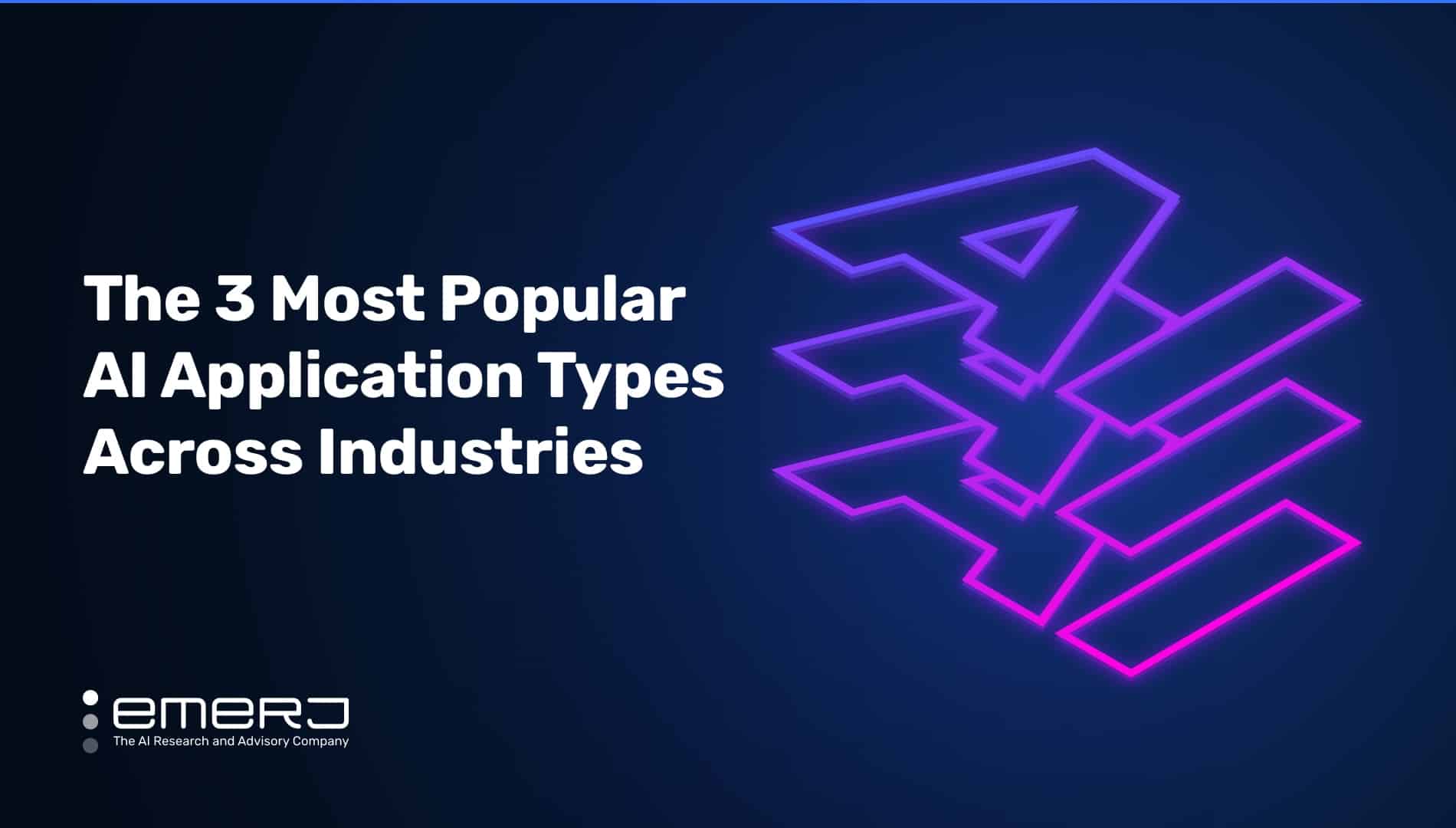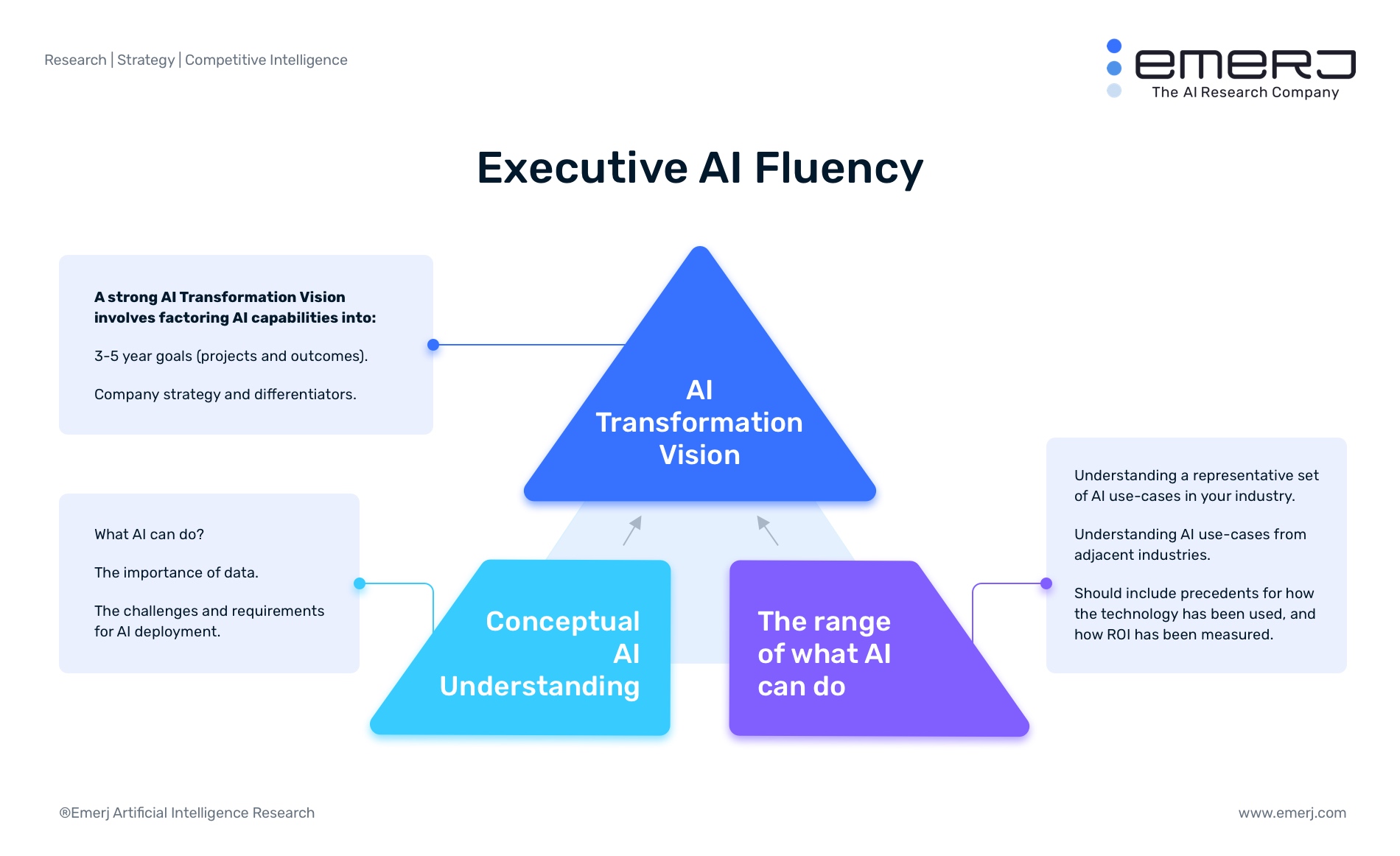
This article was a request from one of our Catalyst members. The Catalyst Advisory Program is an application-only coaching program for AI consultants and service providers. The program involves one-to-one advisory, weekly group Q-and-A with other Catalyst members, and a series of proprietary resources and frameworks to land more AI business, and deliver more value with AI projects. Learn more at emerj.com/catalyst.
Months ago, one of our Catalyst members asked me about the AI use-cases most common across industries. It’s a hard question to answer, as trends are constantly shifting, and use-case types vary drastically.
For example, our AI Opportunity Landscape research shows that over 60% of AI use-cases in eCommerce relate to personalization or recommendations, while less than 12% of the use-case landscape in banking has anything to do with sales or marketing at all.
Despite these drastic differences, there are some use-cases that show up time and time again across sectors – and this week I decided to break down three remarkably broad AI application categories that can be applied to nearly any industry.
If you’re interested in finding AI opportunities in your own firm – or developing an AI product – these examples should serve as fruitful jumping-off points. The guidelines, principles, and examples should also help readers grasp the core concepts that make these applications so common.
We’ll begin, in no particular order, with our first of these three common applications:
Application Type 1: Customer Service Text Analysis
Description:
Extracting meaningful, valuable patterns and insights from mostly unstructured customer service-related text data.
Why it’s so Common:
(Almost) Every Organization Has Customers: Nearly every organization, from hospitals to online furniture retailers has customers – and enterprise-level firms usually have more of that data than any team of people could reasonably read and analyze on their own. There is potential low-hanging fruit in “listening at scale” to customer requests to better inform product, delivery, or customer service teams.
Customer Experience is a Priority for Nearly Any Enterprise: The vast majority of B2C enterprises have a stated desire to improve the customer experience and want digital transformation. Customer experience data is always going to be a part of that deal because they want loyalty. Companies with a huge amount of data usually think about applying AI to modernize their approach for improving customer experience, so this is remarkably common.
It’s Technically Rather Simple: Another reason is that natural language processing for sentiment analysis and finding entities and themes is really quite simple, natural language processing (NLP) for sentiment is a solved problem. When it comes to finding entities and themes in customer data, NLP is an excellent choice. We might need some unique training given the customer’s unique domain, but that should not be difficult given the difficulty of managing copious amounts of customer service data effectively otherwise.
Data:
The data types under this category might come from a variety of sources, including:
- Call center transcripts
- Text or SMS messaging
- Social media comments and mentions
Capabilities:
A handful of capabilities of customer service text analysis applications:
- Automaker: Determine if there is a greater number of customer complaints about rust-related maintenance problem this year compared to the same time last year – or a difference between customer satisfaction scores between different vehicles.
- Online retailer: Determine which product, or which customer service ticket types (i.e. refund requests, delivery-related calls, etc) resulted in the worst customer sentiment – and develop empirically testable hypotheses about reducing that dissatisfaction for customers.
Related Emerj Articles:
- Using NLP for Customer Feedback in Automotive, Banking, and More
- Discovering Customer Experience Trends with Natural Language Processing
- Use Cases of AI for Customer Service – What’s Working Now
Application Type 2: AI-Enabled Search
Description:
Using AI to find answers, insights, or content in the endless reams of enterprise data.
Why it’s so Common:
This is a common adoptive motive because NLP can search documents or pull text even when the text is unstructured. Every organization has oodles of unstructured data – much of which is critical for completing certain workflows – and not finding this data means lost time or even increased regulatory risk. Pulling text from images is far from an impossible task with the right OCR technology. The task does not require using AI to do any predictive analysis, but simply to extract information from a variety of media.
Data:
Data sources might include:
- Documents (mortgage paperwork, legal documents, invoices, etc)
- CRM data
- FAQs
- Regulation or compliance resources
- etc…
Capabilities:
- Banking: Mortgage files for clients in the banking industry, for example. Banks often deal with many workflows and paper forms, and it can be difficult to access information quickly when a client calls for whatever reason. AI-enable search can go through all these processes and forms quickly to find relevant documents and data for a particular client with very little effort.
- Legal: For example, it might be necessary to find a specific clause in legal documents that have to do with refunds or a specific banking regulation issue that might represent a risk for the bank. AI can help identify all the legal documents that have to do with that issue.
In this application, we either want to find the documents or data. We want to find the specific information, concepts, or commonalities among those documents, and this can be quite challenging. Many enterprises typically have chunky systems for storing data, conceived back when these companies had no other choice and did not have AI in mind. The world is changing, and this is a very common problem.
This article details how AI applies in these types of scenarios, specifically when it comes to processing claims as described by storage and information management company Iron Mountain Director of Product Management Anke Conzelmann. She described how it works: “Adjusters can simply ask for similar images to the one showing the damage for the claim they are working on and quickly find relevant claims that had similar damage.”
Related Emerj Articles:
- AI for Enterprise Search – Challenges and Opportunities
- Intelligent Search in Banking and Financial Services – Current Capabilities
- AI-Based Enterprise Search for Claims Processing and Fraud Detection
Application Type 3: Predictive Analytics
Description:
Here I’m referring to predictive analytics in the broadest sense: Taking specific historical and real-time data streams, and turning them into forward-looking predictive models, not just backward-looking dashboards.
Why it’s so Common:
The C-Suite Can Understand It: For better or for worse, companies see AI as either a tool to drive efficiencies and reduce costs like an automation tool or a way to take their existing data dashboards and make them more predictive and forward-looking. This is a very incomplete view of AI, and is not necessarily good or desirable, but it is what the C-suite executives often think. That is not to say what it is necessarily wrong, either, but it is just woefully incomplete.
Certainly the AI fluency of C-level executives varies from company to company, but most executives are unable to envision AI use-cases that vary drastically from what they already know. For this reason, “predictive” dashboards might be an appealing – and understandable – initial foray into AI for many enterprise firms.
(Sometimes) Much of the Data is Already Wrangled: When it is done correctly, these applications are working off of data streams that are already harmonized and under control. The cool thing about predictive analytics is that if we as a business are thinking that this dashboard is cool, but we want to predict the future, it means the data is already available. The client already has control over that data in a historical sense, so as a vendor, there will no longer be a need to go in and overhaul the data infrastructure to get some value out of it.
Nearly every business has some kind of data that they use for business intelligence dashboards already – critical data that helps them steer their company and manage operations. Think of a retailer managing inventory levels or available staff for locations, or a bank managing mortgage applications. By tracking the data sources that are leading indicators of these trends (such as purchase frequent or retail inventory), or the historical information that might impact trends (such as seasonality in the case of mortgage industry), an AI system might help leadership teams make critical projections that go beyond their current mission-critical dashboards.
Data:
Forward-looking predictive maintenance applications might use literally any data source currently being used to create backwards-looking BI dashboards – along with any other kind of forward-indicator data.
Examples might include:
- Purchases and inventory levels for various products (possibly along with proxies for the estimated sales of similar products in the stores of our top competitors)
- Order dates and shipment arrival dates (possibly with the addition of weather data or other factors that could impact shipment arrivals)
- Etc…
Capabilities:

The common factors for enterprises that would apply includes having existing streams of data in or near real-time. This is not data pulled every six months, but data coming in at regular enough cadences such as daily that we can look at it regularly and get a gauged decision of where we stand.
This could be telemetry data from manufacturing equipment, for example. With the data we get in real-time, we know which machines are overheating or the production output we’re getting from different manufacturing lines, and what is contributing to that.
Another example is customer behavior data for an e-commerce website. With real-time data gathered from who is logging in, clicking on things, adding things to the cart, coming back, buying more, and refunding, we can predict what certain types of people will do.
We can look at all of that information in real-time. When I was in eBay headquarters for an interview, I was able to see the giant dashboard projected on the wall. They use it to display real-time data of the kinds of products and product categories purchased in the last 24 hours. It was the coolest thing to watch as it was changing in real-time. I wrote all about my visit and interview at eBay headquarters in this article.
Another common application might be in using real-time data to predict likely incidents of fraud based on the types and percentage of fraud flagged in the past seven days, or whatever the case may be. It may be daily inventory data used as getting proxies for inventory levels based on sales data. The applicable data could be about anything as long as it happens in real or near real-time to make any prediction relevant.
Related Emerj Articles:
- What is Predictive Analytics? – An Informed Definition
- Predictive Analytics in Banking – 4 Current Use-Cases
- Predictive Analytics in Pharma – Current Applications
- Predictive Analytics in the Military – Current Applications
Lessons from Commonly Deployed Applications
Pick Applications That Definitely Work
There are a few takeaways. One is you want to pick applications that definitely work. Natural language processing for sentiment analysis and finding entities is a solved problem. We already know it works in terms of managing clients and keeping them engaged by providing them with information and content that they find relevant.
Of course, NLP will not solve all problems when it comes to customer service as there are many complexities to that issue, and often outside the control of AI. You need to frame AI in an easily provable use case.
You do not want to take any risks by going beyond the available use cases for a known AI application such as NLP when you are trying to deploy AI in an average enterprise. You might be able to do that if you have the funding and/or AI talent to support the initiative, but in most cases, you want to stay within the parameters of what you already know works for that AI application.
A good example of this overreach is the use of AI-powered chatbots. While proven use cases show that chatbots can improve efficiencies in customer service, no use case shows success of chatbots in replying to robust, complicated customer service requests. This is a much harder scenario, and the core science of NLP has more evolution to do before conversation is really possible at all.
Again, a core lesson of these three AI applications is picking proven use cases. Generally speaking, these applications are not for solving hard, new problems, but applying them to known and solved issues.
Find Problems People Already Want to Solve
As discussed above, the reason these three applications are so popular is they address common problems or issues that span different industries. What did we say about customer service? Every company wants to improve customer experience. What do we say about documents, search, and discovery? Every company has clunky systems for storing data. What do we say about predictive analytics? Every company thinks about AI as a way to use data and make predictions.
Clients already have an idea of the problem they want to solve, so it makes sense to go with the flow. Sometimes it might make sense to suggest a counterintuitive AI application to a client because it is going to be more helpful for them in the long term, and you want to build trust and be the leader.
It is understandable that you want to be proactive and suggest things they might not have thought of. However, it is much more practical in most cases to ride the train of existing intent and initiatives, and go along with whatever else the check cutter has in mind.
Add Value Without Overhauling Workflows
Finally, add value without overhauling workflows. For example, in the case of customer service discussed previously, if we want to look at sentiment or trends, we should have a separate interface to get those things done. We should not have to change customer service workloads because it would be too disruptive. All you need is a team to go in, do the analysis and then disperse those lessons throughout the company without actually changing the workflows.
The same applies for document search applications. If you look at search platform companies such as Sinequa, you will see that they embed their search tool into existing workflows of the client. When a client is in the middle of their mortgage workflow, the bank staff can just do a search in a very simple search box and pull up the documents they want without disrupting the normal workflow. In some cases, a document search implies using a new interface, but in general, it should not be astronomically disruptive.
When it comes to predictive analytics as we mentioned earlier, the fact that the company is a good candidate for the application is that data already exists in a dashboard to record the past. You can use the same dashboard to look at the future. Predictive analytics does not imply overhauling how to do business , but implies extracting insight that the data science or subject matter expert team can then disseminate, think about and use to improve their processes.
None of these applications requires drastic changes to existing workflows. That is not the case with applications such as a chatbot, which by definition means pulling customer service people away from certain questions and making it a new part of the workflow then using that information to have meetings and decide how we want to improve our processes. That is much more disruptive than learning from historical customer requests.
That is not to say that not disrupting workflows is the only way to do AI in the enterprise. In fact, I believe that in the future, AI will become more and more disruptive. As AI becomes more trusted and as more applications become proven. I think some workloads are going to change entirely. Some companies are going to take big risks that are going to pay off and other companies are going to follow suit.
However, right now we want to start with companies that are new to AI. We want to be able to embed it without drastically overhauling their workflows in 90% of the time. We do not want to involve massive workflow overhauls for starter projects to avoid resistance to their adoption and deployment.
Discover AI Opportunities with Emerj Plus
These three application types are extremely common across industries because they address common problems, are useful without being disruptive, and come with proven use cases. If you’re looking to start with early AI application ideas that might apply in any industry (and are relatively proven), these might be a good start.
If you want to go one step deeper – learn more about Emerj’s full AI use-case and AI white paper libraries with our all-access Emerj Plus membership.








